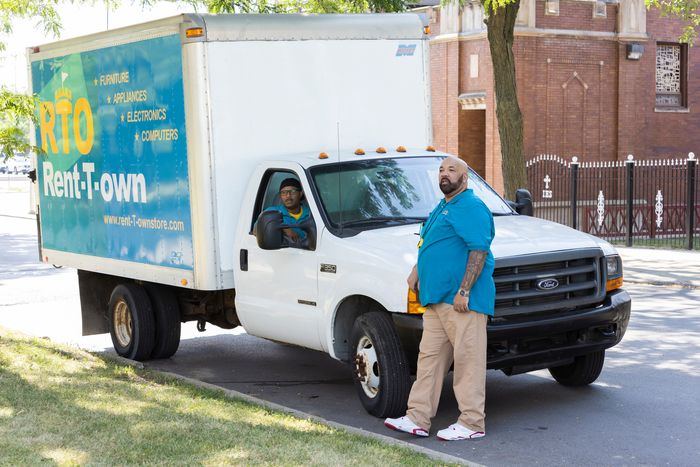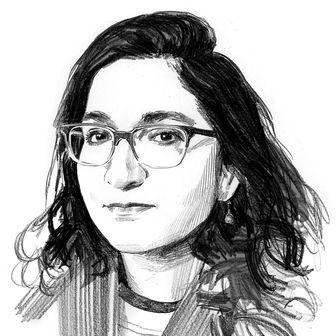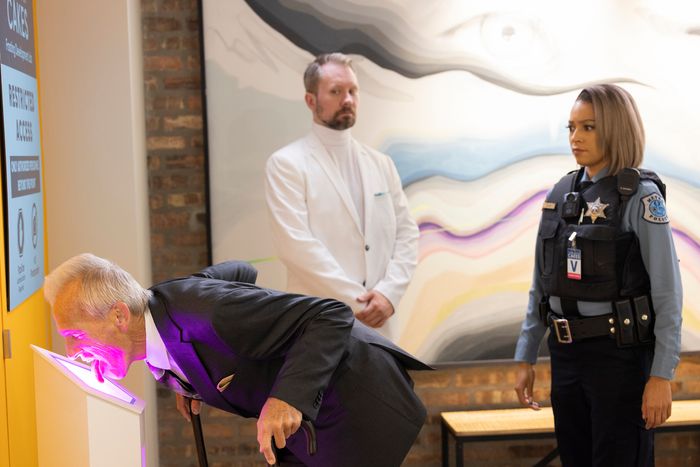
Back when South Side premiered in 2019, series co-creator Bashir Salahuddin described the approach to the show as “take Chicago and turn it into Springfield.” When The Simpsons debuted in 1990, its primary concern was the titular family and its domestic dramas, but once Homer, Marge, Bart, Lisa, and Maggie were distinctly developed, the series gave itself space to explore: the “Treehouse of Horror” special and the Rashomon-style storytelling of “Bart Gets Hit by a Car” of season two, the skeptical optimism of “Mr. Lisa Goes to Washington” and the poignancy of “Bart’s Friend Falls in Love” in season three. The show’s increasingly ambitious golden age, seasons four through ten, further built out Springfield and the wacky antics of its residents, but that couldn’t have happened if The Simpsons hadn’t taken time in the early seasons to establish itself and its community. South Side, in its fantastically funny third season, excels by pulling off the same feat.
In its initial ten episodes on Comedy Central, South Side sketched various portraits of Chicago’s working class with a meticulous level of lived-in detail. (Brothers Bashir and Sultan Salahuddin, who co-created the show with their longtime friend Diallo Riddle and star as Officer Goodnight and Simon, respectively, grew up on the South Side.) In the pilot, “Xbox,” South Side nods at how local media cover the city — “Sad news from the city’s South Side, where yet another senseless act of violence has authorities baffled,” says a white news anchor — but swerves away from defining itself in the same way. Instead, the three creators focused on people who live joyously, quirkily, and nonviolently in Chicago.
Best friends and Rent-T-Own employees Simon and Kareme (Kareme Young) are struggling with their repo-man responsibilities (“When you was a little homie, did you always dream of harassing Black people for their appliances?” asks a local whose Xbox they are repossessing), dealing with domestic hardships (Simon’s outstanding child-support payments), and dreaming of different futures for themselves (Simon as a white-collar office worker; K as an astronaut, astronomer, or other science-related profession). Meanwhile, police-officer partners Goodnight and Turner (Chandra Russell) butt heads over nearly everything from Goodnight’s uptightness and racism toward other Black people (he was transferred to the South Side after arresting a Black professor for entering his own home) to Turner’s unquenchable thirstiness and constant side hustles (her “Ho is life” mantra and second job as a predatory landlord of various rental properties). South Side foregrounded these pairs and their concerns, then moved them through locations that activated other aspects of their personalities while introducing additional characters: RTO staff meetings integrated K’s twin and boss, Quincy (Quincy Young), and co-worker Stacy (Zuri Salahuddin), both of whom have their own peculiarities and aspirations, while police-station briefings confirmed Turner as a beloved cool girl in the department and Goodnight as the target of his fellow officers’ bullying.
As season one progressed, the ensemble grew, and the dialogue came to include references to local high schools, neighborhoods, and suburbs to help explain how the characters became who they are. The storytelling progressed via a medley of long-term subplots: Turner dating local gangster Shaw (LaRoyce Hawkins); Simon’s parenting; Stacy’s singing career; Goodnight’s corny relationship with his limerick-loving wife, Kitty (Rashawn Nadine Scott); K working on his first novel; the competition between the South Side and West Side RTO locations; and the observation that the North Side “feels like a whole different city.” Chicago traditions, such as stepping and mild sauce, formed the basis of A and B plots. And with that carefully constructed sense of people and place, the back half of season one and the entirety of season two got wilder and bolder.
The season-two episode “Ambulance” includes possibly the series’ funniest scene involving the cops, in which the officers explain to their sergeant the surge in food-related gang names. (The Banh Mi, they say, “is a French-Asian fusion gang.”) “Turner’s and Brenda’s Day Off” is an extended homage to Ferris Bueller’s Day Off but with a specifically Black lens on the film’s Chicago setting, while “Life of an Ottoman” is a flashback-filled episode following a piece of RTO furniture as it moves through the city and interacts with familiar characters whose histories are further filled out.
South Side never lost its core defense of Chicago’s everyday citizens — as in the episode “10 Less Minutes,” in which RTO workers unite against their breaks being cut to ten minutes — or its awareness that people in charge are often self-serving. (Riddle’s Alderman Allen Gayle is a shameless opportunist looking for comparisons to Barack Obama.) But because the series was so clear with those considerations early on, it can indulge in more offbeat imaginings, like a clown crime spree or a pyramid-shaped couch that encases a portal showing RTO employees the birth of the universe. This oddness is an asset, and because the show’s lighthearted tone and snappy pace are so consistent, South Side’s experimentation has fluidity as it brings together disparate characters and throws wacky obstacles into their lives.
That’s where the series lands in its latest installment, premiering today on HBO Max. In the first four episodes provided to critics, many of those long-running arcs from seasons one and two, like Turner’s love life and Stacy’s recording-studio time, recede as narrative priorities. Instead, the zaniness is at an all-time high in plots that bring minor characters to the forefront, position primary players against new foes, and continue the series’ cinephilia with references to The Dark Knight Rises, Get Out, Willy Wonka & the Chocolate Factory, and Ready or Not. As per usual, the episodic humor is built on outlandish scenarios to which characters attempt to respond in logical ways until the rhythm of escalation becomes too much, while the ease with which the series’ cast and crew achieve this amplification feels like a reflection of how communal a production South Side is. That the show is made by longtime friends, siblings (Zuri is the co-creators’ sister), and married couples (Bashir and Russell) is evident; these lines of trust give the third season unparalleled confidence.
All the time these characters have spent together in the RTO break room or a police SUV translates into bonds of protection and camaraderie against outside forces that have more power, capital, or influence. South Side has demonstrated this solidarity before, but it’s more explicit this time around and has goofier results. In the season-three premiere, “Heartless,” one of the RTO employees is revealed to be on the run from the military and Chicago police, inspiring the co-workers to unite in protection by pretending the RTO location has bedbugs. The episode is full of examples of the ludicrous ways the characters respond to chaos, with scenes that build out people we’ve seen only briefly before (a pair of cops recognizable from Turner and Goodnight’s debriefings, who bicker with increasing hysteria about the danger of a bedbug infestation) and situations that ultimately zig instead of zagging (in the opening, Officer Goodnight talks down a criminal who’s revealed to be a teenage girl who stole his police car and is mocking him by driving it slightly faster than he can run to catch up). With this approach, South Side can emphatically indulge in the Simpsons method: elevating backgrounders so they have more time to define themselves and introducing new characters who provide additional texture and context to the setting.
In the season’s second episode, “College,” Simon and K hit each other in the face with a raw egg that is revealed to be a high-school student’s sex-education project, and that student connects them with a string of people — an exhausted science teacher, a thirsty vice-principal, an ex of Simon’s — who reflect different lifestyles and perspectives. While all of that is unfurling, there’s an incredibly stupid sight gag in which an RTO employee is hurt, asks Goodnight to track down his attackers, and shows the cop an image he had sketched of the “culprits”: a set of stairs he fell down. South Side’s balance of fast-moving narrative and inane one-off jokes works on all levels here, especially when the series leans into absurdism.
A subplot about Kitty working for a cultlike MLM company that sells frosting “not just for cakes” includes a fantastically dumb scene in which Goodnight realizes all the ways Kitty is trying to sneak frosting into his diet, and it’s enlivened by Bashir Salahuddin and Scott’s total commitment to the bit. Sultan Salahuddin and Young get many opportunities to show off their downbeat chemistry, from a great recurring bit about the racial optics of the term urban legend in “The Laughter” to their dry observations about the self-absorbed antics of a white family in “South Suburbs.” And Russell remains a mischievous shit-stirrer as Turner, her charisma perpetually counterbalancing her character’s worst actions, like using a vigilante stealing from rent-to-own companies to get free furniture for her own rental properties.
As The Simpsons has continued, the array of eccentric, quirky characters who populate Springfield — serial killers and comic-book-store owners, school principals and mob bosses, German foreign-exchange students and fake physicians — sometimes feels at odds with the town’s normalness. How could such an average place, with unremarkable schools, an unremarkable baseball team, and an unremarkable dive bar, be home to so many remarkable people? This may be a comment on how everyone leads a fascinating life if you dig deep enough into their histories, but The Simpsons’ focus on characters has sometimes come at the expense of its central city. How South Side deviates, then, from the inspiration of The Simpsons is one of its strongest qualities. Its delightful silliness is tied to its certainty and specificity; this isn’t Springfield’s Anytown, USA, but a place with its own snow-cone economy, its own principled vigilantes, its own party scene, its own sneaker culture, and its own heritage and habits. After setting its table and building its world, South Side unleashes a breezy whirlwind of narrative possibility in the interplay between Englewood, Chicago, and Englewood Chicagoans.






